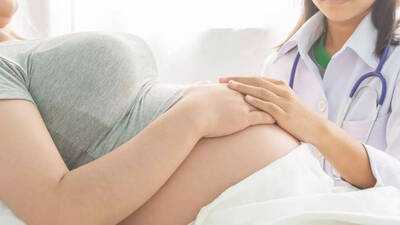Gallbladder stones in pregnancy and postpartum women: Why they form and how you can prevent them
ETimes | November 12, 2025 11:39 PM CST

Gallbladder stones , or cholelithiasis, are small, hardened deposits that form inside the gallbladder, the small organ that stores bile to aid digestion. While often associated with diet or lifestyle, gallstones are surprisingly common during pregnancy and the months that follow. Many women experience sudden abdominal pain, nausea, or discomfort without realising that these could be early signs of gallstones.
Recent studies have shown that pregnancy dramatically increases the risk of gallstone formation due to changes in hormones and metabolism. A reported that gallstone disease is the second most common non-gynaecological condition requiring surgery during pregnancy. This growing concern highlights how something as routine as hormonal fluctuation can trigger an overlooked yet serious health issue among expectant and new mothers.
Why gallbladder stones develop during and after pregnancy
The main reason gallstones form in pregnant and postpartum women lies in hormonal changes. During pregnancy, the body produces higher levels of oestrogen and progesterone which are two hormones essential for maintaining a healthy pregnancy. However, they also alter how bile is produced and stored.
Oestrogen increases cholesterol concentration in bile, while progesterone relaxes the muscles of the gallbladder, causing bile to move more slowly. The result is bile stasis, where bile remains in the gallbladder longer than normal, allowing cholesterol crystals to form and eventually harden into stones.
According to the meta-analysis, the global prevalence of gallstones during pregnancy was around 3.6 per cent, with higher rates in the Americas. Older women, those who have had multiple pregnancies, and individuals with higher body mass index (BMI) were most at risk, particularly during the third trimester. What makes this condition even more intriguing is that the hormonal and physiological changes of pregnancy can continue into the postpartum period. Even after childbirth, bile composition often remains cholesterol-rich, and the gallbladder’s ability to contract may not return to normal immediately, extending the window of risk.
Additional factors, such as rapid postpartum weight loss, insulin resistance, or diets rich in saturated fats, also play a part. These shifts make it clear that gallstones in this period result from a combination of biological and lifestyle influences rather than a single cause.
Why some women are more vulnerable than others
Pregnancy is a time of enormous metabolic change. The liver naturally produces more cholesterol to meet the energy demands of both mother and baby. However, when bile becomes oversaturated with cholesterol and the gallbladder slows down, stone formation becomes almost inevitable.
The frequency of gallstones also rises with each pregnancy. Multiple pregnancies expose the gallbladder to repeated hormonal fluctuations, which over time weaken its ability to contract efficiently. Research published in the European Journal of Obstetrics & Gynecology observed that multiparous women, those who have given birth more than once, are significantly more likely to develop gallstones than first-time mothers.
After childbirth, as oestrogen levels suddenly fall, the bile left in the gallbladder remains thick and cholesterol-heavy. Postpartum women may also use oestrogen-based contraceptives, which can further raise cholesterol levels in bile. Other conditions such as obesity, diabetes, and high cholesterol increase susceptibility. This combination of factors makes gallbladder stones a multifaceted issue, one that blends biology, metabolism, and lifestyle into a single health challenge.
How can gallbladder stones be prevented?
Preventing gallstones during and after pregnancy involves careful lifestyle management and regular health monitoring. The following measures are supported by medical evidence and are easy to follow:
These simple yet effective steps not only help prevent gallstones but also contribute to overall digestive and metabolic health during and after pregnancy.
Can gallbladder stones be treated without surgery?
Most gallstones detected during pregnancy are small and symptom-free, meaning surgery isn’t always required. Conservative or non-surgical management is often the first line of treatment, particularly when the goal is to avoid risk to the mother and baby.
A common non-invasive treatment is ursodeoxycholic acid (UDCA), a naturally occurring bile acid that helps dissolve cholesterol-rich stones by reducing bile saturation. When paired with omega-3 fatty acids such as EPA (eicosapentaenoic acid) and DHA (docosahexaenoic acid), UDCA improves bile flow and lowers the likelihood of recurrence.
A described a postpartum woman who fully recovered from multiple cholesterol gallstones within eight weeks through a regimen of UDCA and omega-3 therapy, without surgery. This highlights the potential of pharmacological therapy when closely monitored.
If gallstones block bile ducts or cause complications such as cholecystitis or pancreatitis, an endoscopic procedure (ERCP) can be used to remove the stones without taking out the gallbladder. In more severe cases, laparoscopic cholecystectomy, a minimally invasive surgery, remains the most effective treatment. When necessary during pregnancy, the second trimester is generally considered the safest window for surgical intervention.
The right treatment depends on individual factors, including the severity of symptoms, overall health, and gestational stage. With growing awareness and medical insight, clinicians can now provide safer, more targeted approaches that protect maternal health while preventing long-term complications.
Disclaimer: Information provided is for educational purposes only and not a substitute for professional medical advice, diagnosis, or treatment.
Also Read |
Recent studies have shown that pregnancy dramatically increases the risk of gallstone formation due to changes in hormones and metabolism. A reported that gallstone disease is the second most common non-gynaecological condition requiring surgery during pregnancy. This growing concern highlights how something as routine as hormonal fluctuation can trigger an overlooked yet serious health issue among expectant and new mothers.
Why gallbladder stones develop during and after pregnancy
The main reason gallstones form in pregnant and postpartum women lies in hormonal changes. During pregnancy, the body produces higher levels of oestrogen and progesterone which are two hormones essential for maintaining a healthy pregnancy. However, they also alter how bile is produced and stored.
Oestrogen increases cholesterol concentration in bile, while progesterone relaxes the muscles of the gallbladder, causing bile to move more slowly. The result is bile stasis, where bile remains in the gallbladder longer than normal, allowing cholesterol crystals to form and eventually harden into stones.
According to the meta-analysis, the global prevalence of gallstones during pregnancy was around 3.6 per cent, with higher rates in the Americas. Older women, those who have had multiple pregnancies, and individuals with higher body mass index (BMI) were most at risk, particularly during the third trimester. What makes this condition even more intriguing is that the hormonal and physiological changes of pregnancy can continue into the postpartum period. Even after childbirth, bile composition often remains cholesterol-rich, and the gallbladder’s ability to contract may not return to normal immediately, extending the window of risk.
Additional factors, such as rapid postpartum weight loss, insulin resistance, or diets rich in saturated fats, also play a part. These shifts make it clear that gallstones in this period result from a combination of biological and lifestyle influences rather than a single cause.
Why some women are more vulnerable than others
Pregnancy is a time of enormous metabolic change. The liver naturally produces more cholesterol to meet the energy demands of both mother and baby. However, when bile becomes oversaturated with cholesterol and the gallbladder slows down, stone formation becomes almost inevitable.
The frequency of gallstones also rises with each pregnancy. Multiple pregnancies expose the gallbladder to repeated hormonal fluctuations, which over time weaken its ability to contract efficiently. Research published in the European Journal of Obstetrics & Gynecology observed that multiparous women, those who have given birth more than once, are significantly more likely to develop gallstones than first-time mothers.
After childbirth, as oestrogen levels suddenly fall, the bile left in the gallbladder remains thick and cholesterol-heavy. Postpartum women may also use oestrogen-based contraceptives, which can further raise cholesterol levels in bile. Other conditions such as obesity, diabetes, and high cholesterol increase susceptibility. This combination of factors makes gallbladder stones a multifaceted issue, one that blends biology, metabolism, and lifestyle into a single health challenge.
How can gallbladder stones be prevented?
Preventing gallstones during and after pregnancy involves careful lifestyle management and regular health monitoring. The following measures are supported by medical evidence and are easy to follow:
- Get regular check-ups and ultrasounds: Pregnant women at higher risk, such as those with obesity, multiple pregnancies, or hormonal therapy, should consider periodic ultrasound screening. Early detection of gallbladder sludge or stones can prevent severe complications.
- Eat a balanced, nutrient-rich diet: A diet high in fibre, fruits, vegetables, and omega-3 fatty acids helps maintain healthy bile flow. Reducing fried foods, refined sugars, and high-fat meals limits cholesterol accumulation in bile.
- Choose smaller, frequent meals: Eating smaller portions more often keeps the gallbladder active, ensuring bile does not stagnate.
- Avoid rapid postpartum weight loss: Quick fat breakdown releases excess cholesterol into bile, increasing the risk of stone formation. Aim for gradual and steady weight reduction instead.
- Stay hydrated: Proper hydration keeps bile fluid and prevents crystallisation inside the gallbladder.
- Include light exercise: Gentle physical activity, such as walking or yoga, supports digestion and encourages bile movement.
These simple yet effective steps not only help prevent gallstones but also contribute to overall digestive and metabolic health during and after pregnancy.
Can gallbladder stones be treated without surgery?
Most gallstones detected during pregnancy are small and symptom-free, meaning surgery isn’t always required. Conservative or non-surgical management is often the first line of treatment, particularly when the goal is to avoid risk to the mother and baby.
A common non-invasive treatment is ursodeoxycholic acid (UDCA), a naturally occurring bile acid that helps dissolve cholesterol-rich stones by reducing bile saturation. When paired with omega-3 fatty acids such as EPA (eicosapentaenoic acid) and DHA (docosahexaenoic acid), UDCA improves bile flow and lowers the likelihood of recurrence.
A described a postpartum woman who fully recovered from multiple cholesterol gallstones within eight weeks through a regimen of UDCA and omega-3 therapy, without surgery. This highlights the potential of pharmacological therapy when closely monitored.
If gallstones block bile ducts or cause complications such as cholecystitis or pancreatitis, an endoscopic procedure (ERCP) can be used to remove the stones without taking out the gallbladder. In more severe cases, laparoscopic cholecystectomy, a minimally invasive surgery, remains the most effective treatment. When necessary during pregnancy, the second trimester is generally considered the safest window for surgical intervention.
The right treatment depends on individual factors, including the severity of symptoms, overall health, and gestational stage. With growing awareness and medical insight, clinicians can now provide safer, more targeted approaches that protect maternal health while preventing long-term complications.
Disclaimer: Information provided is for educational purposes only and not a substitute for professional medical advice, diagnosis, or treatment.
Also Read |
READ NEXT
-
Red Fort Blast Probe: Police Find 2nd Car Linked To Accused, A Red Ford EcoSport

-
DNA Samples Collected from Suspect's Family in Delhi Blast Investigation

-
Arunachal Pradesh Chief Minister Attends National Celebration for Sardar Patel's 150th Birth Anniversary

-
Odisha Chief Minister Extends Bali Yatra Festival by One Day

-
Martin Lewis explains easy way to boost savings above 4%
